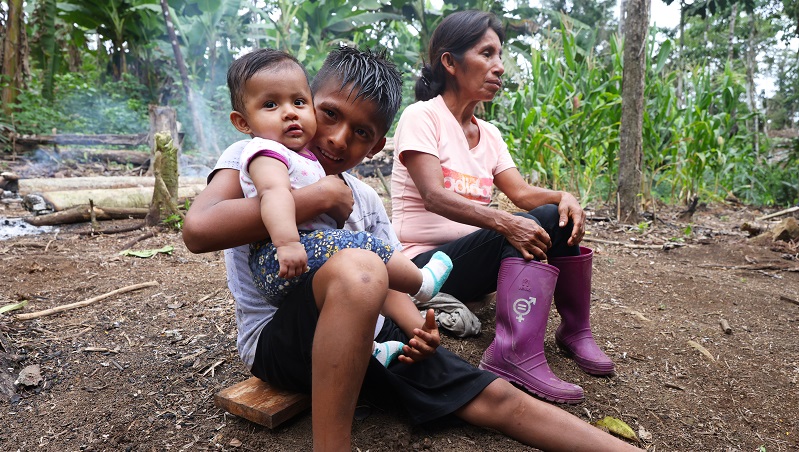Many have heard the expression that tropical rainforests are ‘the lungs of the Earth’. But for Indigenous Peoples, the rainforest is more like our beating heart. Forests are the center and soul of our communities, our culture, and our health.
Sixty million Indigenous Peoples almost wholly depend on forests for our livelihoods. In the Amazon basin, Indigenous People manage more than 30% of forested territories. Likewise, in Mesoamerica, Indigenous People and local communities steward half of the region’s forests.
Satellite imagery shows that deforestation rates in our territories are roughly half of rates found in surrounding lands.
Despite centuries of history and clear evidence that Indigenous Peoples and local communities are the most knowledgeable and experienced stewards of our rainforests, we are not consulted in key decisions about how to conserve them.
Governments battle over carbon removal and renewables in IPCC report
When it comes to using carbon credits as a tool to halt deforestation and stop climate change, it is critical that we are included in decision-making and consultation processes. This is especially true with regards to the Integrity Council for the Voluntary Carbon Market (IC-VCM), which will soon release new criteria for high-quality carbon credits called the Core Carbon Principles (CCP). However, their process to define carbon credit “integrity” was developed without input from Indigenous Peoples and local communities.
The Integrity Council is nearing the end of their process to develop this guidance, and has not adequately consulted us on important issues that directly impact our communities, our livelihoods, and our ability to conserve our rainforests. Consultation with Indigenous Peoples and local communities has been limited to one disappointing webinar plagued by technical problems, and one lunch at Cop27 in Egypt—which, despite featuring a promising and robust discussion, has seen no follow-up.
One urgent issue for our communities that we have not been able to weigh in on is the treatment of high-integrity jurisdictional REDD+ crediting in the Integrity Council’s guidance. Jurisdictional REDD+ credits are designed to incentivise the conservation of large regions of forests that span Indigenous territories, states, and whole countries. For our communities, these credits can unlock the finance needed to support our work to safeguard forests.
With jurisdictional approaches to forest conservation, Indigenous Peoples and Local Communities can generate high-integrity credits based on improvements in emissions and removals across wide regions or territories of forests, preventing deforestation from simply shifting to nearby plots of land.
Because of our efforts, Indigenous territories are often home to High Forest, Low Deforestation (HFLD) regions—meaning that we have high forest cover, yet low rates of deforestation. However, HFLD territories face increasing threats of deforestation. It is Indigenous Peoples who can best defend these territories in circumstances of high vulnerability. However, our only pathway to leverage carbon markets is through HFLD approaches.
It is critical that the Integrity Council does not exclude jurisdictional REDD+ credits, HFLD territories, or Indigenous wisdom from carbon markets. The Integrity Council can get this right by creating guidance for high-quality carbon credits that includes jurisdictional REDD+ programs, including those in HFLD territories, and that reflects Indigenous and local communities’ perspectives and priorities.
I’m a COP veteran. Here are 3 suggestions for the new Loss and Damage fund
The Council should look closely at the Tropical Forest Credit Integrity (TFCI) guide, published by Indigenous Peoples organizations and environmental groups last month. Working together, these groups created guidance to distinguish high-integrity credits that have the greatest forest conservation impact and respect the rights and livelihoods of Indigenous Peoples. The guide shows that jurisdictional REDD+ crediting can be done with high integrity, with Indigenous Peoples and Local Communities at the decision-making table, and with great impact for forests and climate.
Without the inclusion of Indigenous Peoples and Local Communities in the development process, the Council’s Core Carbon Principles will not be effective in the long term. We need to be represented in governing bodies and spaces like the IC-VCM board with a real, legitime representation to contribute to the design and oversight of both the market and individual projects, and have effective channels to address grievances.
The Integrity Council has an opportunity to embody ‘integrity’ by including Indigenous Peoples and Local Communities as partners and honoring our power in the voluntary carbon market. Working together, we can enable finance to flow to one of the most impactful climate solutions—our forests—and Indigenous Peoples and local communities who can best safeguard them.
Levi Sucre is the general coordinator of the Mesoamerican Alliance of Peoples and Forests and Fermin Chimatani is the presidente of the Asociación Nacional de Ejecutores de Contrato de Administración de Reservas Comunales del Perú
The ICVM responded that it is “deeply commited to working in partnership with indigenous people and local communities to ensure the voluntary carbon market protects and promote their rights and livelihoods”.
It said it has three seats on its board for indigenous people and local communities, one member of its “distinguished advisory group” is from the Shuar people and two members of its expert panel have “significant expertise of working with indigenous people and local communities”.
The ICVM said it is recruiting two experts on indigenous people and local communities and has “engaged extensively” with them during its standards development process and offered them an extended deadline to submit responses “in consideration of technical issues on one of the webinars”.
